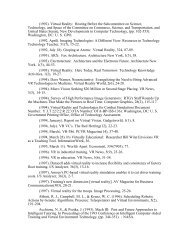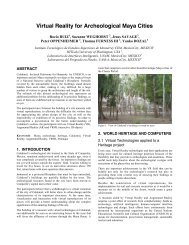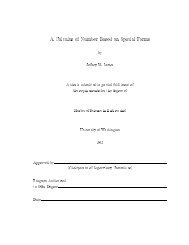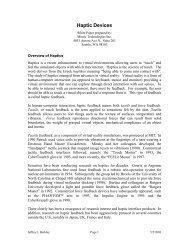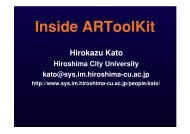The Virtual Motion Controller - Human Interface Technology ...
The Virtual Motion Controller - Human Interface Technology ...
The Virtual Motion Controller - Human Interface Technology ...
Create successful ePaper yourself
Turn your PDF publications into a flip-book with our unique Google optimized e-Paper software.
<strong>The</strong> <strong>Virtual</strong> <strong>Motion</strong> <strong>Controller</strong>:<br />
A Sufficient-<strong>Motion</strong> Walking Simulator<br />
Maxwell J. Wells, Barry N. Peterson, Jason Aten<br />
<strong>Human</strong> <strong>Interface</strong> <strong>Technology</strong> Laboratory<br />
Seattle, WA 98195<br />
e mail mwells@hitl.washington.edu<br />
Abstract<br />
A device is described for simulating pedestrian movement in virtual reality. <strong>The</strong><br />
device is based on the concept of “sufficient motion,” in which the simulator<br />
affords just enough movement in the real world to create a sense of reality in the<br />
virtual world. <strong>The</strong> paper describes the concept, and discusses some<br />
preliminary results obtained with a proof-of-concept device. A section on<br />
requirements lists and discusses seven features of a walking simulator. We<br />
conclude with a description of our future work.<br />
1. Introduction<br />
<strong>The</strong> predominant means for maneuvering through virtual environments is by controlling<br />
vehicles. <strong>The</strong>se vehicles range from the very simple, like a bicycle, to the very complex,<br />
like an F15 aircraft. In some instances, these vehicles are the most appropriate method of<br />
transportation. Indeed, it is often the case that the purpose of the virtual environment is to<br />
train for competence in the control of the vehicle in the real environment.<br />
However, there are many other instances where vehicles are not appropriate. In particular,<br />
for cases in which a participant would normally walk through a real environment, having to<br />
control a vehicle through the equivalent virtual environment can detract from the<br />
effectiveness of the simulation. <strong>The</strong> need to focus on the interface rather than the task<br />
could use cognitive resources which would be best used for other tasks. For these<br />
applications there is a need for a walking simulator. Example applications are infantry<br />
training and some VR games.<br />
2. Requirements<br />
We have identified seven requirements of a locomotion simulator, and they are discussed<br />
below. This list is not meant to be exhaustive.<br />
2.1. Involvement of the Body<br />
By far the most natural and intuitive method for locomoting through virtual environments is<br />
by walking through them, which involves using the legs and body as the controllers. This<br />
leaves the hands free to perform other tasks. It is also reasonable to assume that the natural<br />
involvement of the body may lead to an enhanced sense of presence, better spatial<br />
awareness and better navigation performance.<br />
2.2. Axes of <strong>Motion</strong><br />
A pedestrian in the real world usually moves in two translational axes (x and y), and in one<br />
rotational axis (yaw). <strong>The</strong> direction in which the body is pointing may be different from<br />
the direction of movement. Most pedestrian movement in the z-axis (vertical movement) of
any magnitude is accomplished by moving along (x- or y-axis motion) a platform or stairs,<br />
or by climbing something.<br />
2.3. Hands Free<br />
<strong>The</strong>re are numerous techniques for moving through virtual environments which use the<br />
hands for "fly-throughs." Fly-throughs generally require the participant to use some sort<br />
of hand-controlled device (a wand or a DataGlove). Typically the participant will point his<br />
head or hand in the intended direction of travel and push a button to initiate movement.<br />
Another technique uses hand-held miniatures of the environment which the person uses to<br />
“transport” themselves, or fly from place to place (Pausch et al, 1995). <strong>The</strong> problems with<br />
fly throughs are: 1) it is an unnatural form of locomotion. As Gibson (1958) points out,<br />
humans are not equipped to judge distances through the air. 2) It occupies the hands and<br />
therefore interferes with their use for other activities.<br />
2.4. Intuitive and Natural<br />
A distinction is being made between intuitive (i.e. easy to learn) and natural (i.e. the<br />
technique used in the virtual environment is similar to the technique used in the real world).<br />
A walking interface operated with the hands may be intuitive but not natural. Using a new<br />
method of hand writing for a pen-based computer is natural but not intuitive. An ideal<br />
interface would be both intuitive and natural.<br />
2.5. Multiple Postures<br />
Upright bipedal locomotion is the most energy efficient and widely used method. However<br />
there are occasions when other postures may be adopted. <strong>The</strong>se include crawling,<br />
bending, kneeling etc. A locomotion simulator should allow all of these variants in as<br />
natural a way as possible.<br />
2.6. Feedback<br />
Feedback refers to information provided to the user about their input to the system, and<br />
how that input affects the system. Exertion is one form of feedback. Exertion may be<br />
important in a locomotion simulator because it is known that varying the effort required to<br />
move through an environment changes the perception of the size of that environment<br />
(Reiser et al 1995) . Exertion is also important in some training applications (but, as we<br />
will argue later, its role in simulation is less clear) because of the need for transfer of<br />
training. For example, infantry duty in the real world is associated with extreme exertion.<br />
Unless personnel are trained under these conditions their performance will fall apart in<br />
combat (poor transfer of training).<br />
2.7. Volume of <strong>Motion</strong><br />
One of the requirements of working in a virtual environment is that the volume of<br />
movement of the participant in the real world must be restricted. This is easy to do for a<br />
vehicle, but more challenging for a pedestrian. <strong>The</strong> volume constraint is essential because<br />
of equipment tethers and tracking ranges. Even without these surmountable technological<br />
barriers, there are more immutable real-world barriers, like walls and furniture.<br />
Techniques for constraining the volume of the pedestrian motion, to match the restricted<br />
working volume, have included treadmills, and combinations of a treadmill with some sort<br />
of steering device (e.g. UNC's steerable treadmill (Brooks, 1992), Sarcos' Treadport<br />
(Pratt, 1996). Another approach is to put infantrymen on stationary unicycles, or<br />
Uniports, where the effort of walking is simulated by pedaling (Pratt, 1996). Slater et al<br />
(1995) had participants walk on the spot, and transformed their rate and amplitude of up
and down (z-axis) motion into motion through the virtual world. A technique reported by<br />
Iwata (1996) uses a system of special roller skates and a waist-high frame firmly attached<br />
to the floor which surrounds the participant. <strong>Motion</strong> of the participants feet as they push<br />
against the frame are transduced with the special skates and used to drive the motion of the<br />
virtual world.<br />
Given the above requirements, it would seem that the ideal interface would be some type<br />
of 360 degree treadmill. However our analysis of this type of approach leads us to<br />
conclude that this would be difficult and expensive to produce, and may be unsafe in some<br />
situations (to overcome inertia the system must use, and the user must be coupled to,<br />
several horsepower). Furthermore there are less expensive alternatives which could<br />
provide many of the advantages and none of the disadvantages associated with other<br />
techniques. <strong>The</strong> disadvantages include difficulty in maneuvering with a treadmill, the<br />
inability to adopt multiple postures with a stationary unicycle, and the lack of naturalness<br />
when walking on a frictionless surface.<br />
3. <strong>The</strong> concept of sufficient motion<br />
One alternative involves the concept of “sufficient motion.” A sufficient motion simulator<br />
allows enough motion in the real world to create a sense of presence and realism in the<br />
virtual world. In contrast, a 360 degree treadmill would represent a “full motion”<br />
simulator.<br />
A physical work area (shown as a circle in Figure 1) is defined, with some predefined<br />
center. <strong>The</strong> physical distance between the participant's body and the center of the circle,<br />
and the angle of a line joining those two points is determined. <strong>The</strong> length of the line is used<br />
to determine the magnitude of some derivative of displacement (e.g. velocity or<br />
acceleration). <strong>The</strong> angle of the line is used to determine the direction of that derivative.<br />
Within a predefined distance from the center, the derivative (velocity will be used in the<br />
example) is ignored in favor of an absolute displacement mapping. This allows users fine<br />
control over the position within a small work volume. Figure 2 illustrates a linear<br />
relationship; however there may be others.<br />
body<br />
location<br />
working<br />
area<br />
minimum<br />
distance<br />
center
Figure 1. <strong>The</strong> magnitude and direction of the line from the center to the body location are<br />
used to control motion through the virtual environment.<br />
velocity<br />
(inches/<br />
sec)<br />
minimum<br />
distance<br />
displacement from center (inches)<br />
Figure 2. Graph of velocity vs. displacement from center.<br />
In order to provide some feedback to the user about their position on the working surface,<br />
it is proposed that the surface be overlaid on a large bowl, or similarly concave shape of<br />
suitable size. Thus, the user would be able to find the center (the flat section) of the bowl<br />
without having to look. Other methods of feedback are also possible.<br />
<strong>The</strong> functional components of a sufficient motion simulator are: a means of tracking the<br />
user’s position; movement rules, pertaining to the control order and zones, the transitions<br />
between control orders and the tuning of the algorithms; feedback about the user's input to<br />
the system.<br />
4. One embodiment: the <strong>Virtual</strong> <strong>Motion</strong> <strong>Controller</strong><br />
One embodiment of the sufficient motion concept is called the virtual motion controller<br />
(VMC). A proof of concept was constructed. It consisted of a waistbelt suspended at<br />
waist-height by elastic straps. <strong>The</strong> other ends of the elastic straps were connected to a<br />
circular frame which was free to pivot about the center of the working volume (see Figure<br />
3). Feedback to the user was implemented through the force from the set of elastic straps.<br />
<strong>The</strong> force increased as displacement from center increased.
Figure 3. A proof-of-concept of the <strong>Virtual</strong> <strong>Motion</strong> <strong>Controller</strong>.<br />
5. Features of Sufficient <strong>Motion</strong> Devices<br />
In training, many skills consist of physical elements (exertion) and cognitive elements.<br />
Using fighter pilot training as an analogy, a simulator can be effective in a training regime if<br />
it provides cognitive training (enemy attack patterns, responses to those patterns etc.)<br />
without all of the physical stressors (g, heat etc.). After the pilot has learned the cognitive<br />
task he can then rehearse them under more stressful real world conditions. <strong>The</strong> concept<br />
being proposed provides sufficient motion for creating a sense of realism, but removes the<br />
need for physical exertion. It is envisioned that the cognitive and physical elements can be<br />
integrated in other, real-world training environments.<br />
One of the justifications for full-motion is that the exertion required to move through an<br />
environment provides the user with a sense of the size of the space (Reiser et al 1995).<br />
However it is also known that this sense is plastic. Research by Pelah and Barlow (1996)<br />
had subjects run on a treadmill and then measured their walking speed on solid ground.<br />
<strong>The</strong> subjects showed a decrease in speed, indicating that after running and getting nowhere<br />
on the treadmill their brains had re-calibrated the link between what the eyes saw and what<br />
the body felt. <strong>The</strong> aftereffect lasted about 10 minutes, and was less marked for subjects<br />
with more treadmill experience. This plasticity may work to the advantage of the sufficient<br />
motion simulator, as users learn to link limited motion with movement through the virtual<br />
world.<br />
Sufficient motion opens up the realm of locomotion with minimal effort. Users who may<br />
be discouraged by the need to run to participate in a VR game (or may be unable) could<br />
still experience the thrill without the exertion.
6 .<br />
A proof of concept<br />
We developed a simple virtual world, comprised of seven tunnels spread out over a flat,<br />
smooth floor. Participants were asked to navigate, using the VMC, from one end of the<br />
floor, through the tunnels, to the other end. Of the approximately thirty participants, most<br />
navigated the course in from one to three minutes. Overall, the feedback that we received<br />
was encouraging. People liked using their bodies to control their virtual movement.<br />
Furthermore, the device was very intuitive; people began to navigate immediately with no<br />
procedural instructions.<br />
From this initial group of participants we learned that the correct tuning of the movement<br />
rules is critical. Any discontinuities in velocity and acceleration cause significant difficulty.<br />
We also found evidence that vertical translation should be constrained for terrestrial<br />
navigation tasks.<br />
7. Future Work<br />
<strong>The</strong>re are four areas that we will concentrate on in our future work. <strong>The</strong>se are: training,<br />
performance testing, simulator sickness and concept refinement.<br />
Training will compare subjects who learn to navigate in a real world, with those who are<br />
trained to navigate in a virtual world, using the VMC. This experiment will be part of an<br />
ongoing investigation into the transfer of training being conducted by the Department of<br />
Psychology at the University of Washington.<br />
Our performance studies will compare the VMC with the Logitech Cyberman, the Division<br />
Helmet and Wand, and a force-feedback joystick that we have developed. We will evaluate<br />
subject performance, assessing both speed and accuracy for navigational tasks. Dependent<br />
variables will include: the number of collisions made by the subject, the course completion<br />
time, and the distance deviations from the optimal paths. Furthermore, we will compare<br />
the user's sense of spatial orientation while navigating, by monitoring their frequency and<br />
duration of map checks and recorded verbal protocol. <strong>The</strong> results from this experiment will<br />
be presented at the VRAIS conference.<br />
Simulator sickness is a potentially serious impediment to the implementation of VR<br />
applications. <strong>The</strong> <strong>Human</strong> <strong>Interface</strong> <strong>Technology</strong> Lab is currently pursuing a research<br />
program in simulator sickness, funded by the Air Force Office of Scientific Research.<br />
During the course of the development of the VMC we will compare it with other<br />
navigational techniques to determine whether whole-body involvement in locomotion<br />
affects simulator sickness.<br />
Finally, concept refinement refers to both refinements of the particular embodiments<br />
(different feedback, different tracking methods etc.) and to refinements of the movement<br />
rules and algorithms. Figure 4 shows one such area of exploration. <strong>The</strong> VMC allows<br />
extraordinary turning performance in comparison with real pedestrian movement. This<br />
may be advantageous or not We would like to determine which, and tune the system<br />
accordingly.
possible with<br />
the VMC in virtual<br />
world<br />
rate of turn<br />
possible in the<br />
real world<br />
speed<br />
Figure 4. Rate of turn vs. speed for a pedestrian in the real world, and that possible using<br />
the VMC in a virtual world.<br />
8. References<br />
Brooks, Frederick P. Jr. (1992). Final Technical Report Walkthrough Project. (TR 92-<br />
026 to Computer and Information Science and Engineering National Science Foundation).<br />
Chapel Hill: Department of Computer Science, University of North Carolina.<br />
Gibson, J. J. (1958). Visually Controlled Locomotion and Visual Orientation in Animals.<br />
In E. Reed and R. Jones (Eds.), Reasons for Realism, (pp. 148-163). Hillsdale, New<br />
Jersey: Lawrence Erlbaum Associates.<br />
Iwata, H. and Fuji T. (1996). <strong>Virtual</strong> Perambulator: A Novel <strong>Interface</strong> Device for<br />
Locomotion in <strong>Virtual</strong> Environment. Proceedings of the IEEE 1996 <strong>Virtual</strong> Reality<br />
International Symposium: IEEE Computer Science Press, 1996.<br />
Pausch, Randy, Burnette, Tommy, Brockway, Dan & Weiblen, Michael E. (1995).<br />
Navigation and Locomotion in <strong>Virtual</strong> Worlds via Flight into Hand-Held Miniatures. In<br />
Robert Cook (ed.), Computer Graphics Proceedings: SIGGRAPH 95 Conference<br />
Proceedings (pp. 399-400). New York: <strong>The</strong> Association for Computing Machinery, Inc.<br />
Pelah, A. and Barlow, H.B. (1996). Visual illusion from running. Nature, vol. 381, p<br />
283.<br />
Pratt, D. R. (1996). Untitled Electronic Mail document sent to Barry Peterson (<strong>Human</strong><br />
<strong>Interface</strong> <strong>Technology</strong> Lab), describing the Sarcos Uniport and Treadport <strong>Interface</strong> Devices,<br />
dated March 9, 1996.<br />
Reiser, J.J., Pick, H.L., Ashmead, D.H., and Garing, Ann (1995) Calibration of human<br />
locomotion and models of perceptual-motor organization. Journal of Experimental<br />
Psychology: <strong>Human</strong> Perception and Performance. Vol. 21 480-497<br />
Slater, Mel, Usoh, Martin Usoh & Steed, Anthony (1995). Taking Steps: <strong>The</strong> Influence<br />
of a Walking Technique on Presence in <strong>Virtual</strong> Reality. ACM Transactions on Computer-<br />
<strong>Human</strong> Interaction Special Issue on <strong>Virtual</strong> Reality Software and <strong>Technology</strong>, (pp. 201-<br />
219). New York: Association for Computing Machinery.




